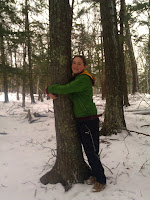 |
| Hugging trees is almost as fun as environmental education. |
Before I start, you should know that if you don't have the time to read the whole story, you can always skip to the bottom of the post to find out what I've learned so far!
Why I'm Doing This
 |
| My class at Conserve School |
 |
| Roseville Area Middle School |
When I got back I wanted to start a project right away, but I have to admit it seemed a little overwhelming. Fortunately, I had really helpful guidance from a lot of other people- my high school Earth Group, Conserve School, and other environmental educators I know. For a few weeks I looked at several possible strategies and locations for a club before deciding on Roseville Area Middle School, where I'd been a student for two years.
 |
| Not all meetings are like this! |
To start the ball rolling I emailed one of the science teachers at RAMS who ran an environmental club a few years ago. It was great to have someone eager to help with both planning the club and advising it. She got approval for the club from the activities director at the school, and we had a meeting to start planning. Meetings get a bad rap- this one was really helpful. In just a few minutes one afternoon we figured out the start date, what activities the club would do (we'll start with making green cleaning supplies and doing a simple energy audit), and what needed to be done to make everything work.
 |
| If I had a megaphone, I would use it a lot |
Making Everything Work
That's what I'm doing right now- making things work. It turns out that there's a lot to do before the club's first meeting at the end of February. Most importantly, I'm writing flyers and announcements to advertise the club at RAMS. I'm also recruiting volunteers from the high school to help out- the best strategy for that is reminding them of how good volunteer hours look on college applications. There is also planning what the club's first project will be, what events the club might attend, what organizations might want to support the club, and how to get more students interested in joining after the club starts. Fortunately, the fact that I'm starting an environmental club is exciting enough to make all the tasks fun and worthwhile.
What I Learned
 |
| It's okay to rely on other people! |
I've never started a club before, and I don't even know all that much about environmental education. But fortunately, there are a lot of people who actually do know what they're talking about. All I need to do is find those people, send a few emails, put in some simple work, and show up. I'm not going to say it's easy, but I know that anybody can do it!
Thanks for reading, and check back soon for another action-packed story from "I'm Starting an Environmental Club!"


